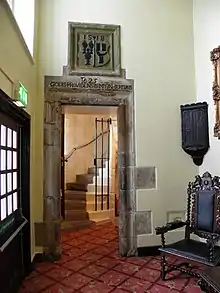Ballygally Castle
Ballygally Castle is in the village of Ballygally, County Antrim, Northern Ireland, located approximately 3 miles (5 kilometres) north of Larne. The castle overlooks the sea at the head of Ballygally Bay. Now run as a hotel, it is the only 17th century building still used as a residence in Northern Ireland, and is reputed to be one of the most haunted places in all of Ulster.[1]
| Ballygally Castle | |
|---|---|
 | |
 | |
| General information | |
| Type | Castle |
| Location | Ballygally, County Antrim, Northern Ireland |
| Coordinates | 54°53′56″N 5°51′40″W |
| Completed | 1625 |
| Design and construction | |
| Architect(s) | James Shaw |
Features

The castle is described as "a living postcard—a charming, almost teal-colored Scottish baronial castle overlooking the sea in Northern Ireland."[2][3][4]
The rectangular Scottish baronial-style castle has 4 stories, walls of about 1.5 meters thick, 4 corner turrets and a flanking tower at the northeast side with an entrance and stone spiral stairs. Originally it was enclosed by a bawn with 4 corner turrets. In the 1840s, the side nearest the sea was removed to accommodate the new coast road.[5]
History
The castle was built in 1625 by James Shaw, of Scotland, who had come to the area and rented the land from Randal MacDonnell, the Catholic Earl of Antrim for £24 a year.[6] It is reputed to be the oldest occupied building in Ireland.[7] Over the main entrance door to the castle, leading to the tower, is the Middle Scots inscription "Godis Providens is my Inheritans".[4] The bawn and walled garden are registered as Scheduled Historic Monuments at grid ref: D3725 0781.[8]
During the Great Rebellion of 1641 the Irish garrison stationed at Glenarm tried to take the castle, then more fortified than today, several times but without success.[5]
In the late 1730s, the Shaw children were tutored by the later pioneering educator and master of a Belfast "play school", David Manson. For many years, one of the apartments in the castle was known as the "Manson room".[9]
Around 1760 the castle buildings were extended as the squire, Henry Shaw, married a Miss Hamilton, who had two sisters and who all came to live within the castle.[5]
In 1799, the castle passed to William Shaw, the last squire of Ballygally. The family's wealth was exhausted, and within a few years he sold the property. It then passed through several hands, including use as a coast guard station, before being purchased in the early 1950s by Cyril Lord. The textile millionaire refurbished the castle as the hotel seen today.[5][10]
Reputed hauntings
The castle is reputed to host a number of ghosts. The small room in the corner turret of the castle is known as "The Ghost Room" and is not used as a room in the hotel.[2]
In 2003, manager Olga Henry had said after spending some time in the hotel, "I'm sort of very skeptical about the whole supernatural thing and ghosts. But the more I stay here and work here, the more I think there's definitely something in this hotel."[2] According to Henry, one guest was staying in one of the rooms in the tower beneath the "Ghost Room" and in the middle of the night he awoke and thought he was at home and one of his children had laid a hand on his back. He woke up and said that he could a hear a child running about the room and laughing but nothing could be seen so he ran into the lobby in his boxers shorts in fright.[2] In December 2003, Henry had set up the "Dungeon Room" in the tower as they were expecting guests and ordered the table neatly in preparation for meal. She locked the room and later checked up on it and the table was now a mess with unfolded napkins and glasses with an unusual scum around them were now arranged in a circle on the table.[2] Mediums spending the night at the castle have often reported that they've detected more ghosts than there were guests actually staying at the hotel. [2]
 Turret Room
Turret Room Staircase
Staircase Ghost Room
Ghost Room Plaque
Plaque
See also
References
- "Haunted Ulster". BBC. Retrieved 28 May 2011.
- Belanger, Jeff (January 2009). World's Most Haunted Places. The Rosen Publishing Group. p. 16. ISBN 978-1-4358-5178-8.
- O'Neill, B (ed). (2002). Irish Castles and Historic Houses. London: Caxton Editions. p. 18.
- "Ballgally Castle". Celtic castles. Archived from the original on 23 July 2011. Retrieved 28 May 2011.
- "Castles.nl - Ballygally Castle". www.castles.nl. Retrieved 1 April 2023.
- Huston, Cleburne (1968). Bold legacy; the story of the Houston-Huston ancestors: 1150 to 1800. Printed by Texian Press. p. 87.
- West, Chris (2022). "The Shaws of Down and Antrim in the 17th Century (part 2)". Chris West Ancestry Blog. Retrieved 1 April 2023.
- "Ballygalley" (PDF). Scheduled Historic Monuments (2015). Northern Ireland Environment Agency. Archived from the original (PDF) on 27 April 2015. Retrieved 21 April 2015.
- Frogatt, Richard. "The Dictionary of Ulster Biography". www.newulsterbiography.co.uk. Retrieved 25 April 2021.
- Franklin, Luke (22 December 2021). "Ballygally Castle | Ballygally, Northern Ireland | Ultimate guide of Castles, Kings, Knights & more | Castrum to Castle". castrumtocastle.com. Retrieved 1 April 2023.